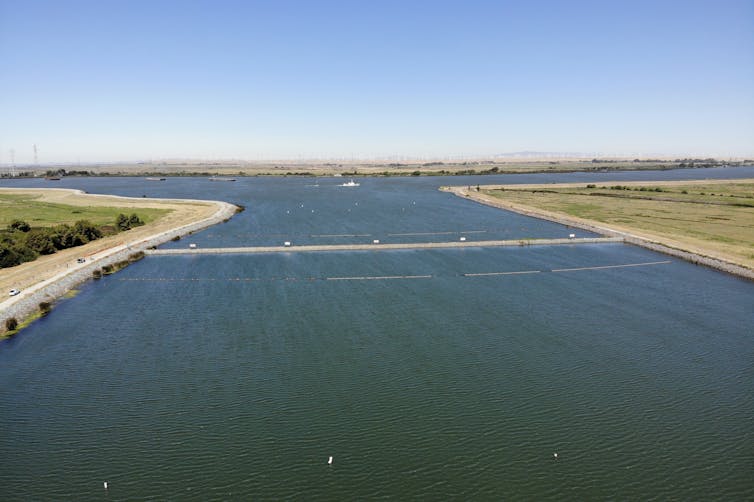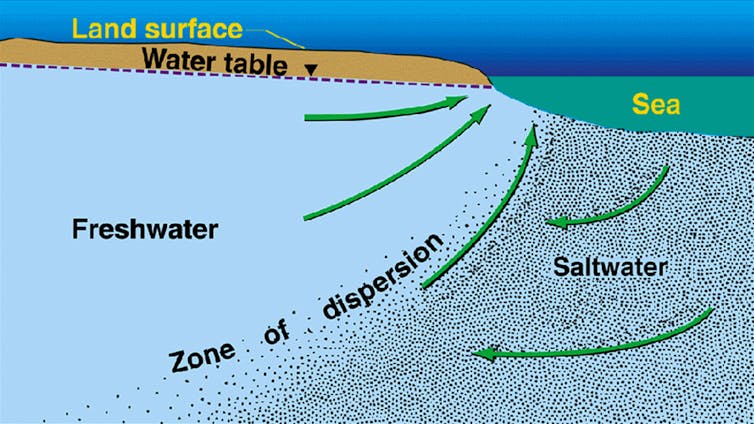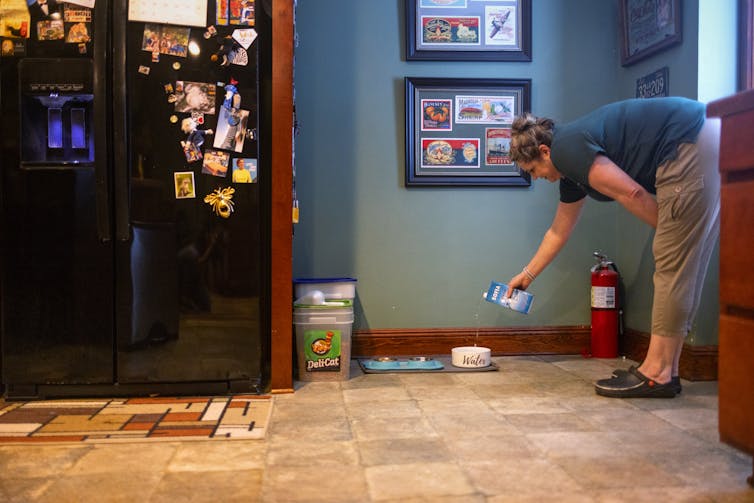
Holly Michael, University of Delaware
Seawater intrusion is the movement of saline water from the ocean or estuaries into freshwater systems. The seawater that has crept up the Mississippi River in the summer and early fall of 2023 is a reminder that coastal communities teeter in a fragile land-sea balance.
Fresh water is essential for drinking, irrigation and healthy ecosystems. When seawater moves inland, the salt it contains can wreak havoc on farmlands, ecosystems, lives and livelihoods.
I am a coastal hydrogeologist and have studied water across the land-sea interface for 25 years. I think of seawater intrusion as being like a seesaw: The place where fresh water and salt water meet is the balance point between forces from land and forces from the sea.
A push from the land side, such as heavy rainfall or high river flows, moves the balance point seaward. A push from the sea side – whether it’s sea-level rise, storm surge or high tides – moves the balance point landward. Droughts or heavy use of fresh water can also cause seawater to move inland. As climate change and population growth stress freshwater supplies, one result will be more seawater intrusion.

When the ocean moves upriver
The current seawater intrusion in the lower Mississippi River is due primarily to drought in the Midwest, which has reduced the river’s volume. Both the magnitude of reduction in river flow and the length of time that the river is low influence how far upriver the salt water moves. As of Oct. 2, 2023, the saltwater “wedge” in the Mississippi had moved nearly 70 miles upstream from the river’s mouth.
This isn’t the first time that low water on the river has allowed seawater to move inland. But as climate change raises sea levels and causes more severe weather anomalies, intrusion will become more common and will inch farther upstream.
And the problem isn’t unique to the Mississippi. In Delaware, seawater is traveling farther up small tidal streams during storms and the highest tides, flooding farmland and killing crops.
In the Sundarbans of India and Bangladesh – one of the largest coastal mangrove forests in the world – seawater is intruding into the mouth of the Ganges River. The main causes there are upstream dams and water diversions from the river for irrigation and navigability, plus encroachment due to sea-level rise. Seawater intrusion could threaten many types of plants and animals in this UNESCO World Heritage Site, which is home to countless rare and endangered species.
Invading underground
Another interface between fresh water and salt water at the coast is less obvious because it’s underground. Many coastal communities draw their freshwater supply from groundwater – clean water that moves through pore spaces between grains of sand and soil.
Groundwater doesn’t just stop at the coastline: Under the ocean floor, the groundwater is salty, and somewhere between land and the ocean, there is an underground meeting point. It typically is landward of the coastline because salt water is denser than fresh water, so it has a greater force and naturally pushes in. But just as with a river, that interface moves when groundwater levels drop on land or water levels rise offshore.
In groundwater basins of central and southern California, widespread pumping has caused groundwater levels to drop hundreds of feet in some areas. This is tipping the seesaw and causing groundwater from the sea to move far inland. Accessible groundwater has supported irrigated agriculture in these areas, but now the double hazard of reduced groundwater availability and seawater intrusion threatens crops like strawberries and lettuce.
Seawater intrusion into groundwater is happening all over the world, but perhaps the most threatened places are communities on low-lying islands. Fresh groundwater is often the sole source of water for drinking and irrigation on small islands, and it exists in a thin lens that floats on top of saline groundwater.
The lens can shrink in response to droughts, pumping and sea-level rise. It can also become salty from floodwater infiltration during storms or high tides.
In the Marshall Islands, for example, a combination of sea-level rise and wave-driven flooding is predicted to make many islands uninhabitable by the end of the century.

Shifting the balance
As salt water continues to encroach on freshwater systems, there will be consequences. Drinking water that contains even 2% seawater can increase blood pressure and stress kidneys. If salt water gets into supply lines, it can corrode pipes and produce toxic disinfection by-products in water treatment plants.
Seawater intrusion reduces the life span of roads, bridges and other infrastructure. It has been implicated as a contributor to the Champlain Towers South condominium collapse in Surfside, Florida, in 2021. Seawater intrusion changes ecosystems, creating ghost forests as trees die and marshes move inland.
Smart management can tip the seesaw back toward the sea. Limiting surface water extraction and groundwater pumping, or injecting treated wastewater into vulnerable aquifers, can increase the force pushing against intruding salt water.
Constructing seawalls or maintaining healthy dune systems also can help hold seawater at bay, though these approaches protect only against saltwater flooding and infiltration at the surface, not underground. Pumping out saline groundwater or installing underground barriers can keep deeper salt water from moving inland.
Being proactive is best, because once groundwater is contaminated, it’s hard to remove the salt. If salt water does penetrate inland, communities can manage water quality by constructing desalination plants and switching to salt-tolerant crops.
Another option is to let nature take its course. Allowing marshes to migrate inland can compensate for losses at the coastline as sea level rises. This preserves critical habitats, enhances flood protection and stores carbon at rates far exceeding most terrestrial ecosystems – dialing back the acceleration of climate change.![]()
Holly Michael, Director, Delaware Environmental Institute, and Professor of Earth Sciences and Civil and Environmental Engineering, University of Delaware
This article is republished from The Conversation under a Creative Commons license. Read the original article.